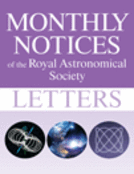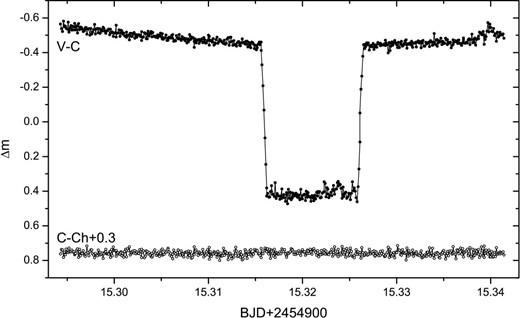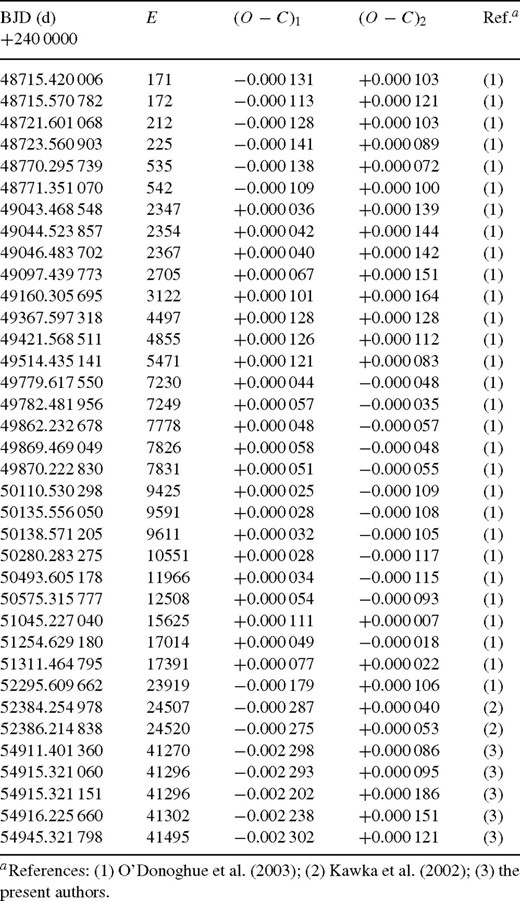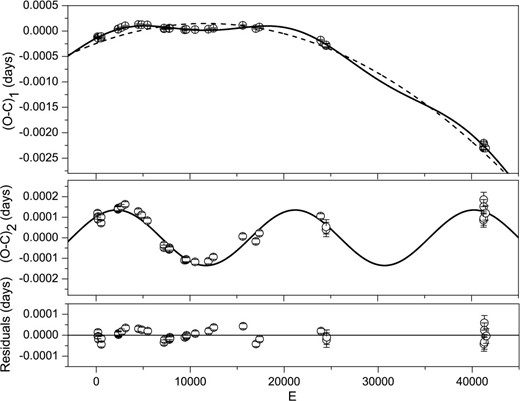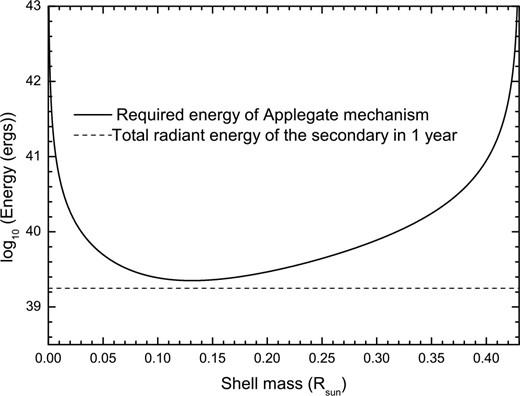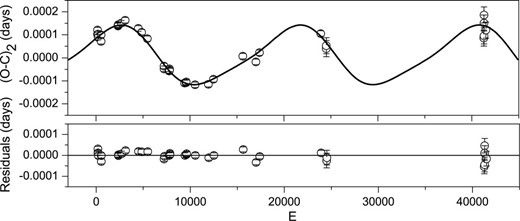-
PDF
- Split View
-
Views
-
Cite
Cite
S.-B. Qian, W.-P. Liao, L.-Y. Zhu, Z.-B. Dai, L. Liu, J.-J. He, E.-G. Zhao, L.-J. Li, A giant planet in orbit around a magnetic-braking hibernating cataclysmic variable, Monthly Notices of the Royal Astronomical Society: Letters, Volume 401, Issue 1, January 2010, Pages L34–L38, https://doi.org/10.1111/j.1745-3933.2009.00780.x
Close - Share Icon Share
Abstract
Detections of Jupiter-like giant planets in orbit around short-period white dwarf binaries should provide insight into the formation and evolution of circumbinary planets (planets orbiting both components of short-period binaries), as well as into the ultimate fate of planets and the late evolutionary stage of binary stars (e.g. the evolution of the common envelope). However, to date no planets have been detected as companions to such close binaries. Here, we report the discovery of a giant planet orbiting the only known hibernating cataclysmic variable (CV), QS Vir, with a period of 7.86 yr. We analysed the variations of the orbital period of the eclipsing white dwarf–red dwarf binary, and a very small-amplitude cyclic change is found to be superimposed on a long-term period decrease. The period oscillation has the smallest amplitude among close binary stars and can be plausibly interpreted as the light-travel time effect via the presence of a third body. We found that the tertiary component is a giant planet with a mass of ∼6.4 MJupiter at a distance of ∼4.2 astronomical units (au) from the binary. The continuous decrease is explained as angular momentum loss via magnetic braking which is driving the evolution of the hibernating CV into a normal cataclysmic binary.
Introduction
With an orbital period of about 3.618 h and containing a white dwarf primary and a red dwarf (with spectral type of M3.5–M4) secondary (O'Donoghue et al. 2003), QS Vir (=EC 13471−1258) is the only known hibernating cataclysmic variable (CV) where the red dwarf component is temporarily and marginally detached from its Roche lobe, and no mass transfer or accretion disc is observed in the system. It is therefore important for understanding CV evolution. This binary was discovered during the Edinburgh–Cape blue object survey (e.g. Kilkenny et al. 1997; Stobie et al. 1997) and showed deep and total eclipses (O'Donoghue et al. 2003). Moreover, the well-detached configuration means that the eclipses are not influenced by accretion-driven radiation from other components observed in CVs (e.g. the accretion discs and hotspots). These properties help the determinations of eclipse times to have a high precision, and very small-amplitude orbital period variations can be detected by analysing the ‘observed minus calculated’ (O – C) diagram (constructed by the observed times of light minimum minus those calculated with a given linear ephemeris). Therefore, it is one of the most promising systems for detecting very low-mass companions and providing valuable information on CV evolution through the determination of period changes.
If there is a tertiary companion orbiting an eclipsing binary, the wobble of the binary's barycentre will cause the orbital period and thus the O – C diagram to show a cyclic change. Therefore, extra-solar planets hosted in eclipsing binaries as a tertiary companion can be detected by measuring the O – C variation. This method has been used to detect tertiary brown dwarf companions in the sdB-type eclipsing binaries HW Vir (e.g. Qian et al. 2008; Lee et al. 2009) and HS0705+6700 (Qian et al. 2009), and in the eclipsing white dwarf binary V471 Tau (Guinan & Ribas 2001). It is similar to the radio approach to detecting planets around pulsars (e.g. Wolszczan & Frail 1992; Backer, Foster & Sallmen 1993; Wolszczan 1994). In this Letter, we report the detection of a giant extrasolar planet in orbit around the hibernating CV QS Vir by using this method.
New Observations and Orbital Period Change of QS Vir
The white dwarf–red dwarf eclipsing binary QS Vir was monitored from 1992 to 2002 with the South African Astronomical Observatory (SAAO) 0.75- and 1.0-m telescopes, and plenty of times of mid-ingress and mid-egress were determined with those high-speed photometric observations (O'Donoghue et al. 2003). Those data are very useful to investigate the changes of the orbital period. The mid-eclipse times used here were derived by averaging the times of mid-ingress and mid-egress. Apart from the SAAO data, four mid-eclipse times were determined with photometric observations published in the literature (Kawka et al. 2002). However, only two are used for the present analysis, because the other two show large scatters when compared with the general trend formed by the other data points. To get more data for this eclipsing binary, it was monitored with three telescopes (the 2.4-, 1.0- and 0.6-m telescopes) at Yunnan Observatory. Three mid-eclipse times, BJD 245 4915.321 151, 245 4916.225 660 and 245 4945.321 798, were obtained by using a VersArray 1300B CCD camera attached to the 2.4-m telescope, and two mid-eclipse times, BJD 245 4911.401 360 and 245 4915.321 060, were obtained with two DW 436 CCD cameras attached to the 0.6-m and the 1.0-m telescopes, respectively. During the observations, the integration time for each CCD image was 5 s and the readout time of the CCD camera was 1.8 s. Therefore, the time resolution of the photometric data is about 6.8 s. We estimate that the error of the mid-eclipse times is about half of the time resolution, i.e. 0.000 04 d. The light curve observed with the 2.4-m telescope on 2009 March 24 is displayed in Fig. 1.
Light curve of QS Vir in the V band obtained with the 2.4-m telescope on 2009 March 24. The coordinates of the comparison star are  and
and  , while those of the check star are
, while those of the check star are  and
and  refers to the magnitude difference between QS Vir and the comparison star, and C − Ch to the magnitude difference between the comparison star and the check star.
refers to the magnitude difference between QS Vir and the comparison star, and C − Ch to the magnitude difference between the comparison star and the check star.

Mid-eclipse times of the white dwarf–red dwarf eclipsing binary star QS Vir.

 (or 1.2 s in about 1000 yr). The dashed line in the upper panel refers to the linear period decrease, while the solid one represents the combination of the linear decrease and the cyclic period change. After the linear period change is removed, the (O−C)2 values are displayed in the middle panel where a small-amplitude periodic variation can be seen more clearly. The amplitude of the cyclic change is the smallest known among close binary stars (Kreiner, Kim & Nha 2001).
(or 1.2 s in about 1000 yr). The dashed line in the upper panel refers to the linear period decrease, while the solid one represents the combination of the linear decrease and the cyclic period change. After the linear period change is removed, the (O−C)2 values are displayed in the middle panel where a small-amplitude periodic variation can be seen more clearly. The amplitude of the cyclic change is the smallest known among close binary stars (Kreiner, Kim & Nha 2001).The (O−C)1 curve of QS Vir from the linear ephemeris of O'Donoghue et al. (2003) is shown in the upper panel. The solid line in the upper panel refers to a combination of a long-term period decrease and a cyclic period variation. The dashed line represents the continuous decrease in the orbital period. The (O−C)2 values with respect to the quadratic part of equation (2) are displayed in the middle panel where a cyclic change is more clearly seen. After both the long-term decrease and the cyclic change are removed, the residuals are plotted in the lowest panel.
Discussion and Conclusions
To interpret cyclic period changes in close binaries containing at least one late-type star, a mechanism, based on solar-type activity cycles, was proposed by Applegate (1992). In the mechanism, a certain amount of angular momentum is periodically exchanged between the inner and the outer parts of the convection zone, and therefore the rotational oblateness of the star and thus the orbital period will vary while it goes through its active cycles. This mechanism was supported by the observational fact deduced from the period changes of 101 Algols that all cases of alternating period changes are restricted to binaries with spectral types of the secondary later than F5, and no cyclic variations were detected for systems with spectral types earlier than F5 (Hall 1989). However, as discussed in the literature (e.g. Qian et al. 2008), the period changes of those Algols were mainly based on visual and photographic observations. Some recent investigations have shown that cyclic period variations are also common for early-type binaries, such as BH Cen, V701 Sco (Qian, Liu & Kreiner 2006), TU Mus and V382 Cyg (Qian et al. 2007), which can be plausibly interpreted by the presence of a third body. Moreover, if the cyclic variation is produced by the Applegate mechanism, all close binaries containing at least one cool component star should show cyclic period change, but this is not true. The Applegate mechanism predicted that there is a connection between the variation of the light curve and the change of the orbital period. However, to date, no reliable connections have been found.
Moreover, for QS Vir, the energies required to produce the period oscillation for different shell masses of the secondary have been calculated with the same method as used by Brinkworth et al. (2006) in the case of the pre-CV NN Ser. We discovered that the required energies are larger than the total radiant energy of the M-type component star in 1 yr (see Fig. 3), suggesting that the mechanism of Applegate has difficulty interpreting the cyclic period variation. During the calculation, we chose a temperature of T2 = 3100 K for the M-type component (O'Donoghue et al. 2003) and its luminosity was computed by using L2 = (R2/R⊙)2(T2/T⊙)4L⊙. Therefore, the cyclic period change in QS Vir is more plausibly interpreted as the presence of a third body. Depending on the position of the QS Vir system around the barycentre of the triple system, the binary is cyclically close to or farther away from the Sun and the time of eclipse periodically advanced or delayed.
A plot of the energy required to cause the period oscillation of QS Vir by using Applegate's mechanism as a function of the assumed shell mass of the cool component (solid line) (Applegate 1992). The dashed line is the total radiant energy of the secondary component star in 1 yr.

 and T is the orbital period of the third body divided by the binary period. The results are as follows: a0 =+0.000 005(±0.000 003), a1 =+0.000 097(±0.000 005), b1 =+0.000 076(±0.000 006), a2 =−0.000 018(±0.000 006) and b2 =+0.000 014(±0.000 001). The semi-major axis of the orbit of the binary pair around the barycentre of the triple system, a′12 sin i′= 0.021(±0.001) au (i′ is the inclination of the orbital plane formed by the central binary and the third body), and the orbital parameters of the third body, i.e. the eccentricity, e′= 0.37(±0.08), the longitude of periastron from the ascending node, ω′ =
and T is the orbital period of the third body divided by the binary period. The results are as follows: a0 =+0.000 005(±0.000 003), a1 =+0.000 097(±0.000 005), b1 =+0.000 076(±0.000 006), a2 =−0.000 018(±0.000 006) and b2 =+0.000 014(±0.000 001). The semi-major axis of the orbit of the binary pair around the barycentre of the triple system, a′12 sin i′= 0.021(±0.001) au (i′ is the inclination of the orbital plane formed by the central binary and the third body), and the orbital parameters of the third body, i.e. the eccentricity, e′= 0.37(±0.08), the longitude of periastron from the ascending node, ω′ =  , and the time of periastron passage, τ′= BJD 244 8688.0(±78.3) d, were computed by using the formulae given by Kopal (1959). Residuals after subtracting the light-travel time effect of the tertiary component are displayed in the lower panel of Fig. 4. By comparing these residuals with those displayed in the lowest panel of Fig. 2, it is shown that the elliptical orbit fits observations better, especially for the data between E = 2000 and 20 000.
, and the time of periastron passage, τ′= BJD 244 8688.0(±78.3) d, were computed by using the formulae given by Kopal (1959). Residuals after subtracting the light-travel time effect of the tertiary component are displayed in the lower panel of Fig. 4. By comparing these residuals with those displayed in the lowest panel of Fig. 2, it is shown that the elliptical orbit fits observations better, especially for the data between E = 2000 and 20 000.Theoretical light-travel time effect orbit of the giant planet companion in QS Vir with an eccentricity of e′= 0.37(±0.08) calculated with the method of Kopal (1959). After the light-travel time effect of the giant planet is subtracted, the residuals are plotted in the lower panel.
With the published absolute parameters given by O'Donoghue et al. (2003), we determined the mass function and the mass of the tertiary companion as f(m) = 1.58(±0.21) × 10−7 M⊙ (the mass of the Sun) and M3 sin i = 0.006 15(±0.000 27) M⊙, respectively. When  , the mass of the third body corresponds to 0.006 15 ≤M3≤ 0.0140 M⊙– it should be a giant extrasolar planet. However, circumbinary planets were expected theoretically, at least initially, to have a nearly coplanar orbit with the central binary (e.g. Bonnell & Bate 1994). Therefore, by assuming that the tertiary companion in QS Vir is coplanar to the eclipsing binary (i.e.
, the mass of the third body corresponds to 0.006 15 ≤M3≤ 0.0140 M⊙– it should be a giant extrasolar planet. However, circumbinary planets were expected theoretically, at least initially, to have a nearly coplanar orbit with the central binary (e.g. Bonnell & Bate 1994). Therefore, by assuming that the tertiary companion in QS Vir is coplanar to the eclipsing binary (i.e.  ) (O'Donoghue et al. 2003), the mass of the third body is calculated as M3 = 0.006 36 M⊙ which means M3 = 6.65 MJupiter. In this case, the third body would be a giant extrasolar planet at a distance of 4.2 au (1 au is the mean distance between the Earth and the Sun) from the binary.
) (O'Donoghue et al. 2003), the mass of the third body is calculated as M3 = 0.006 36 M⊙ which means M3 = 6.65 MJupiter. In this case, the third body would be a giant extrasolar planet at a distance of 4.2 au (1 au is the mean distance between the Earth and the Sun) from the binary.
One of the most interesting things that we have learnt about extrasolar planets during the last 17 years is that they can exist almost anywhere. In the past several years, the quest for Jupiter-like giant planets has been extended to a completely different kind of host star, i.e. white dwarfs (e.g. Debes, Ge & Ftaclas 2006; Farihi, Becklin & Zuckerman 2008; Hogan, Burleigh & Clarke 2009). However, sub-stellar object companions to white dwarfs are rare. To date only four brown dwarfs orbiting white dwarfs have been found (e.g. Becklin & Zuckerman 1988; Farihi & Christopher 2004; Maxted et al. 2006; Steele et al. 2009), and only three white dwarfs are known to be wide companions to stars hosting extrasolar planets (e.g. Mayor et al. 2004; Lagrange et al. 2006; Mugrauer, Neuhäuser & Mazeh 2007). However, no extrasolar planets have been detected as companions to short-period white dwarf binary stars. The detection of the first planet in the white dwarf–red dwarf binary QS Vir will provide us with more knowledge on the formation and evolution of planets.
Hydrodynamic simulations of the formation and evolution of giant planets in a circumbinary disc showed that for a binary with orbital separation ab = 1 au, eccentricity eb = 0.1 and mass ratio qb = 0.2, the eccentricity damping provided by the disc can enable planetesimal accretion to take place in the regions located less than 4 au from the central binary (Scholl, Marzari & Thébault 2007; Pierens & Nelson 2008). This physical process may have occurred for the giant planet in QS Vir. However, theoretical investigations revealed that post-common envelope binaries like QS Vir come from the evolution of the common envelope after the hydrogen in the cores of the primary components runs out and they expand into red giant stars (Paczynski 1976; Iben & Livio 1993). It is possible that the orbit of the giant planet in QS Vir has been changed during this evolutionary stage.
Planets more massive than two Jupiter masses around low-mass stars survive the planetary nebula stage down to orbital distances of about 3 au (Villaver & Livio 2007). The distance between the giant planet companion and QS Vir is about 4.2 au, and thus it would survive the common envelope evolution of the parent binary. The survival of a giant planet orbiting the sdB star V391 Peg was recently reported (Silvotti et al. 2007). However, the situation of QS Vir seems to be more complex. The progenitor of the QS Vir system is composed of at least three components; after the evolution of the common envelope stage, both the M-type component and the giant planet survive, which could give some constraints on stellar evolution in such systems and the interactions between red giants and their companions.

 s−1. This is about two orders smaller than the observed value (
s−1. This is about two orders smaller than the observed value ( s−1). Therefore, the observed continuous decrease in the orbital period can be explained by angular momentum loss (AML) via magnetic braking of the secondary component. A calculation with the equation (given by Tout & Hall 1991)
s−1). Therefore, the observed continuous decrease in the orbital period can be explained by angular momentum loss (AML) via magnetic braking of the secondary component. A calculation with the equation (given by Tout & Hall 1991) 
 in units of R2⊙ M⊙ yr−1. If we take the Alfvén radius to be the same as that of the Sun (i.e. RA = 15 R⊙), the required mass-loss rate should be
in units of R2⊙ M⊙ yr−1. If we take the Alfvén radius to be the same as that of the Sun (i.e. RA = 15 R⊙), the required mass-loss rate should be  −1. The secular AML will drive the evolution of the binary system into a normal CV.
−1. The secular AML will drive the evolution of the binary system into a normal CV.The evolution of long-period (P > 3 h) CVs is driven by AML via magnetic braking, and CVs are expected to evolve from a higher mass secondary with longer period to a lower mass secondary with shorter period (Andronov, Pinsonneault & Sills 2003). However, details of the CV evolution are still open. The detection of evidence for magnetic braking in the only known hibernating CV can provide new clues on CV evolution.
Acknowledgments
This work is partly supported by the Chinese Natural Science Foundation (No.10973037, No.10903026 and No. 10778718), the National Key Fundamental Research Project through grant 2007CB815406, the Yunnan Natural Science Foundation (No. 2008CD157) and the Special Foundation of President and West Light Foundation of the Chinese Academy of Sciences. The authors thank the referee for useful comments and suggestions that helped them to improve the original manuscript. New CCD photometric observations of the system were obtained with the 60-cm, the 1.0-m and the 2.4-m telescopes in Yunnan Observatory.
References


